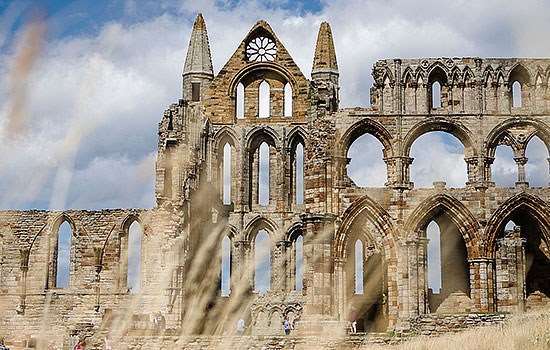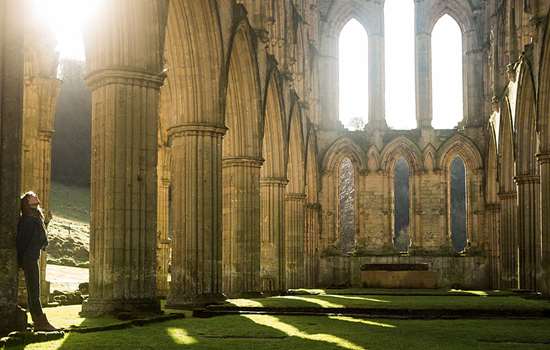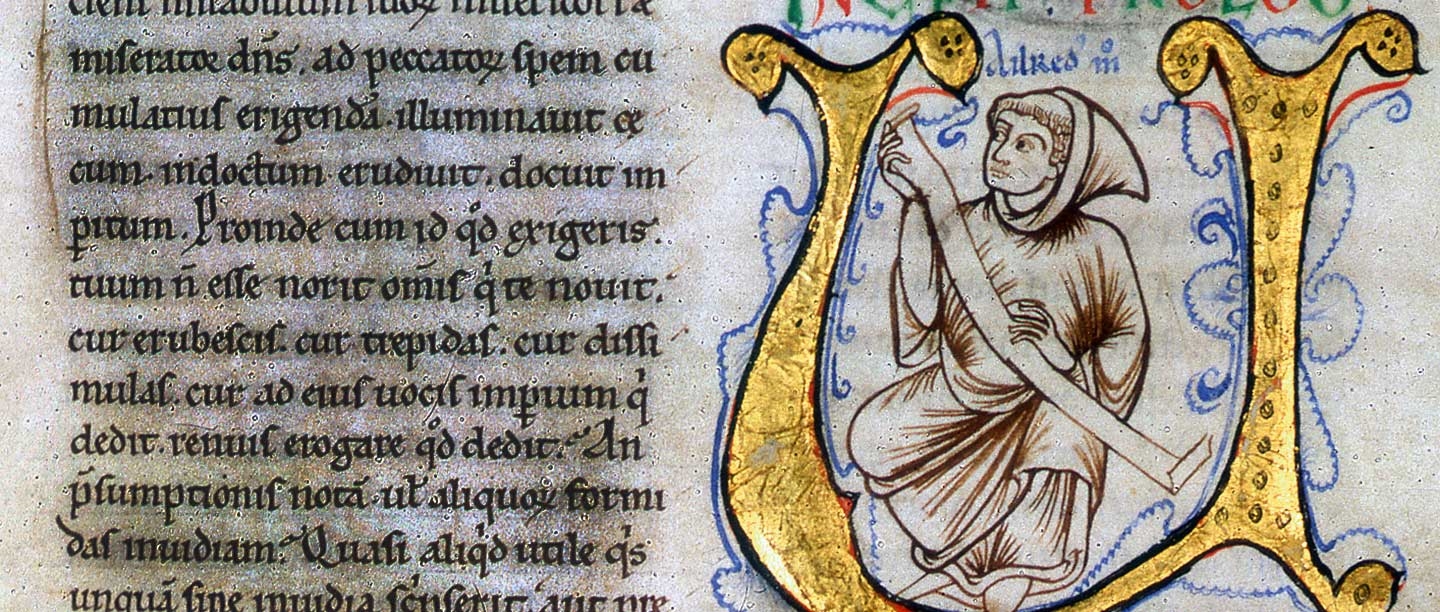A Native Northerner
Aelred was born in 1110 to Anglo-Saxon parents. His father, Eilaf, was hereditary priest of the church of St Andrew, Hexham, which was associated with some of the great Anglo-Saxon saints of Northumbria, to whom Aelred was deeply devoted throughout his life.
A talented and pious boy, at about the age of 14 he entered the service of King David I of Scotland. Aelred rose to become the king’s seneschal, or steward, undertaking diplomatic missions on his behalf. It was during a mission to Archbishop Thurstan of York in 1134 that Aelred learned of Rievaulx Abbey. Reforming Cistercian monks had arrived there just two years earlier under the leadership of Abbot William. The rigour of the monks’ life inspired Aelred to seek admission to the community.
Read more about the history of Rievaulx AbbeyAelred the Monk
Aelred rapidly adjusted to the monastic life. Walter Daniel describes how he excelled at prayer, study and manual labour – the three pillars of the monastic day. His experience at the royal court of Scotland also proved valuable to Abbot William, who in 1142 chose Aelred to act as an emissary to the pope in Rome.
On his return to Rievaulx, Aelred was appointed as the abbey’s novice master, with responsibility for the care and instruction of young men preparing for life within the cloister. Aelred wrote a guide for novices, The Mirror of Charity. It vividly evokes the physical hardships and spiritual rewards of life as a Cistercian monk:
Our food is scanty, our garments rough; our drink is from the stream and our sleep upon our book. Under our tired limbs there is a hard mat; when sleep is sweetest we must rise at a bell’s bidding … self-will has no scope; there is no moment for idleness or dissipation … Everywhere peace, everywhere serenity, and a marvellous freedom from the tumult of the world.
Abbot of Rievaulx
In 1143, Aelred was appointed abbot of Revesby Abbey, a newly founded Cistercian monastery in Lincolnshire. However, he was destined to greater things and in 1147 was recalled to Rievaulx to serve as its third abbot. Over the next 20 years, the already thriving monastery became a religious, cultural and economic powerhouse.
According to Walter Daniel, Aelred ‘doubled everything’, the size of the community reaching 640 men. The name of Rievaulx became famous at the royal courts of England, France and Scotland and to popes in Rome. The monastery attracted recruits from across Europe. These included men who had struggled to settle at other monasteries. In Aelred, they found a loving and compassionate father and were able to fulfil their monastic vocation. Walter Daniel and his brother monks held their abbot in such esteem that they called him ‘our Aelred’.
Aelred oversaw the construction of many of the abbey’s buildings, including its enormous church, chapter house, novices’ chamber, monks’ infirmary and cloister. The latter was at the heart of the monastery and was a place of silence and contemplation. Aelred’s own words give an idea of the spiritual contentment of Rievaulx’s monks in their cloister:
The day before yesterday, as I was walking the round of the cloister of the monastery, the brethren were sitting around forming as it were a most loving crown … I found no-one whom I did not love, and no-one by whom, I felt sure, I was not loved. I felt such joy that it surpassed all the delights of the world.
The Mirror of Charity
Author and Preacher
As well as being an inspirational monastic leader, Aelred was also a prolific author. His writings include saints’ lives, histories, guides to the monastic life and theological works. Thirteen works by Aelred are known to survive and his writings feature prominently in a late 12th-century catalogue of Rievaulx’s library. He is best known for his book On Spiritual Friendship, which presents an ideal of friendship that people still find inspirational to this day.
No medicine is more valuable, none more efficacious, none better suited to the cure of all our temporal ills than a friend to whom we may turn for consolation in time of trouble, and with whom we may share our happiness in time of joy.
On Spiritual Friendship
The abbot was also a talented preacher and in 1163 delivered a sermon at Westminster Abbey when the relics, or remains, of St Edward the Confessor were moved to a new shrine.
Illness
But by then Aelred was seriously ill. His final years were blighted by a combination of arthritis, shingles, kidney stones, gout and serious lung disease.
So dreadfully afflicted was he that I have seen him suspended in a linen sheet, held by a man at each of its four corners, being carried to relieve himself or from one bed to another. A mere touch affected him like a piercing wound
Walter Daniel
Aelred’s health was so poor that he was permitted to live in his own house, close to the abbey’s infirmary. Walter Daniel, who cared for his ailing abbot, movingly described Aelred’s fortitude in the face of these crippling afflictions. Despite his ill health, Aelred continued to be a loving father to his monks, who would visit him in this lodging.
Aelred knew that his death was approaching and called his house his ‘mausoleum’. Throughout his illnesses, he derived huge comfort from his love of Christ.
Death and Sainthood
Aelred died on 12 January 1167 and was immediately regarded as a saint. During his lifetime, he had exhibited many of the characteristics associated with medieval saints, including the power of prophecy and the ability to perform miraculous cures. A further indication of Aelred’s sanctity was revealed during preparation of his body for burial, when his skin was found to be ‘clearer than glass, whiter than snow’.
He was first buried in the abbey’s chapter house, next to the body of William, the first abbot, who was likewise venerated by the monks as a saint. In about 1220, the east end of the church at Rievaulx was rebuilt on a magnificent scale to provide a setting for Aelred’s relics, which were placed in a precious-metal container, or reliquary, above the high altar. In 1476, the Cistercian order granted the Rievaulx monks permission to celebrate Aelred’s feast on 12 January.
Legacy
Veneration of St Aelred extended beyond the confines of the abbey. In 1526, a local man left his rosary beads to the saint’s shrine in the hope that Aelred would pray for him in heaven. The abbey also had a ‘belt of St Aelred’. This was a portion of his habit that was tied around the stomachs of women in labour in the belief that it would ease the pains and dangers of childbirth.
In 1538, Rievaulx Abbey and Aelred’s shrine fell victim to Henry VIII’s Suppression of the Monasteries. The monks were cast out with pensions, the building reduced to ruins, and the saint’s shrine melted down. Aelred’s extraordinary life and achievements meant that his memory endures to this day and his feast day on 12 January continues to be marked by both Anglicans and Roman Catholics.
A Gay Icon
Recently, some historians and theologians have found evidence in Aelred’s writings to suggest that he was emotionally and physically attracted to other men. Aelred lived in a very male world and he is known to have been sexually experienced before becoming a monk, though whether this was with men or women is not recorded.
When training to be a monk, Aelred was so troubled by desires of the flesh that he would immerse himself in freezing water. However, he strictly adhered to his vow of chastity and he abhorred any form of sexual contact between monks. The love Aelred expressed for his monks in his writings was purely spiritual.
LGBTQ+ Christians find inspiration in Aelred’s writings, holding the saint in special esteem, and debate about his sexuality continues. Aelred would doubtless have wished for this topic to be discussed in a spirit of friendship.
Explore More
-

History of Rievaulx Abbey
Read more about the history of Rievaulx Abbey, from its foundation in 1132 to its 20th-century preservation.
-
A Mini Guide to Medieval Monks
Learn how to tell Carthusians from Cistercians with this handy animated introduction to medieval monastic orders.
-

LGBTQ+ History
LGBTQ+ history has often been hidden from view. Find out more about the lives of some LGBTQ+ individuals and their place in the stories of English Heritage sites.
-

Abbeys and Priories
Discover more about the history of some of England's most significant monastic sites and those who lived in them.
-

Visit Rievaulx Abbey
England’s most majestic and complete abbey ruins in a lovely wooded valley.
-
Listen to the Podcast
Learn more about Aelred in our podcast episode, where senior properties historian Dr Michael Carter and interpretation assistant Nick Collinson discuss Aelred’s life and significance.
